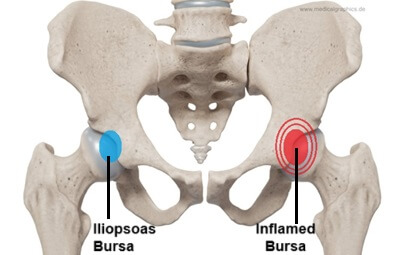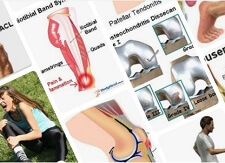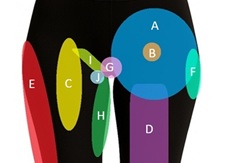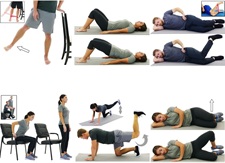- Home
- Hip Pain Diagnosis
- Hip Bursitis
- Iliopsoas Bursitis
Iliopsoas Bursitis
Written By: Chloe Wilson, BSc(Hons) Physiotherapy
Reviewed by: KPE Medical Review Board
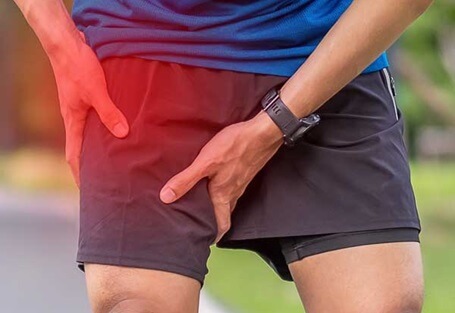
Iliopsoas bursitis causes pain in the front of the hip and down the inner thigh.
It can make activities such as walking, climbing stairs, getting up from a chair and crossing your legs difficult and painful.
Irritation and inflammation of the iliopsoas bursa at the front of the hip is typically caused by repetitive overuse, trauma, muscle imbalance or underlying conditions. It is a common cause of front hip pain and upper thigh pain.
Also known as iliopectineal bursitis or iliopsoas syndrome, most cases settle down within a few weeks with a combination of rest, exercises, physical therapy and in some cases, steroid injections or surgery.
Here we look at what is iliopsoas bursitis, the common causes and symptoms, how it is diagnosed and the best treatment options.
What is Iliopsoas Bursitis?
Iliopsoas bursitis is a painful type of hip bursitis caused by irritation and inflammation of the iliopsoas bursa.
The iliopsoas bursa is a small fluid-filled sac located between one of the hip muscles (iliopsoas) and the front part of the hip joint.
The iliopsoas muscle is crucial for hip flexion and stability of the lower spine, especially during activities like walking, running, and climbing stairs. The bursa acts as a cushion to reduce friction between the hip bone and surrounding soft tissues when the leg moves.
If the bursa becomes irritated, usually due to overuse, injury, or repetitive stress, it gradually swells and becomes inflamed, resulting in iliopsoas bursitis. This leads to pain and discomfort in the front of the hip or groin area and may reduce hip mobility.
Though it’s a less common type of bursitis compared to shoulder bursitis or knee bursitis, iliopsoas bursitis can significantly affect mobility and cause persistent pain, especially for athletes, dancers, or individuals with active lifestyles.
Causes of Iliopsoas Bursitis
Common causes of iliopsoas bursitis include:
- Overuse Or Repetitive Movements: Activities that involve frequent or repetitive hip flexion/extension, e.g. running (particularly uphill), cycling, rowing, swimming or dancing, can put excessive strain on the iliopsoas muscle and bursa, leading to inflammation. Athletes and individuals who regularly engage in high-impact activities are at a higher risk of developing this condition.
- Hip Joint Problems: Structural abnormalities in the hip joint, e.g. arthritis, hip labral tears, or impingement, can cause mechanical stress in the joint and lead to increased pressure on the bursa.
- Trauma Or Injury: A direct injury or impact to the front of the hip, such as a fall or road traffic accident, can damage the bursa and cause it to become inflamed.
- Muscle Imbalances: Weakness or tightness in the surrounding muscles, especially the hip flexors, hamstrings, and core, can lead to abnormal movement patterns. These imbalances place increased stress on the iliopsoas bursa, contributing to inflammation.
- Prolonged Sitting: Sitting for long periods, especially with poor posture, can compress the iliopsoas muscle and bursa, leading to irritation. Individuals with desk jobs or those who frequently sit with the hips flexed for long periods are more likely to develop bursitis.
- Leg Length Discrepancy: A significant difference in leg length can result in an uneven gait, causing extra strain on one side of the hip and leading to the development of iliopsoas bursitis.
Iliopsoas Bursitis Symptoms
The symptoms of iliopsoas bursitis can range from mild discomfort to severe, debilitating pain, depending on the extent of the inflammation.
Common symptoms associated with iliopsoas bursitis include:
- Hip Pain: The most characteristic symptom of iliopsoas bursitis is a deep, aching pain in the front of the hip or groin area that gets worse with activity. The pain may radiate down towards the inner thigh and knee, or up towards the lower back. Some people also experience a sharp pain with certain movements.
- Discomfort With Leg Movement: Movements that involve hip flexion, such as lifting the knee toward the chest or crossing your legs, can exacerbate the pain. Activities like getting up from sitting, tying shoelaces, climbing stairs, or performing sit-ups can be particularly uncomfortable. Pain may also intensify when the leg is extended backwards, such as when pushing-off while walking or running. This can make it difficult to walk or stand for long periods, and you may end up walking with a slight limp.
- Stiffness: People with an inflamed iliopsoas bursa often experience stiffness and reduced range of motion in the hip joint, making it difficult to extend or rotate the leg fully. This stiffness can be particularly noticeable after periods of inactivity or in the morning after waking up.
- Swelling Or Tenderness: In some cases, localized swelling or tenderness over the front of the hip joint can be felt, especially when the bursa is significantly inflamed. Pressing on the affected area may elicit pain.
- Snapping or Clicking Sensation: Some people with iliopsoas bursitis experience a snapping or clicking sensation in the hip, known as snapping hip syndrome. This occurs when the iliopsoas tendon catches on nearby structures as it moves over the hip joint.
Diagnosis of Iliopsoas Bursitis
The diagnosis of iliopsoas bursitis typically involves a thorough clinical evaluation, including a detailed history of your symptoms, physical examination, and imaging studies to confirm the diagnosis and rule out other conditions.
Patient History
Your doctor will ask questions about your symptoms, activity level, and any recent injuries. A detailed history helps identify any repetitive activities or traumatic events that may have contributed to the onset of bursitis.
Physical Examination
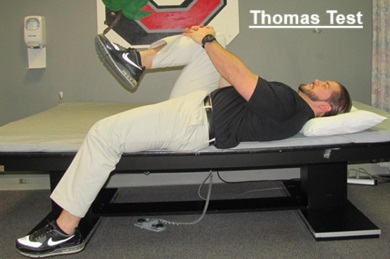
The doctor will assess your hip's range of motion and palpate the area to identify pain points.
Combined flexion, abduction, and external rotation of the hip may increase discomfort, and is often accompanied by an audible “snap” which helps confirm the diagnosis.
Special iliopsoas bursitis tests, such as the Thomas test, may be performed to check for tightness or irritation in the iliopsoas muscle.
Imaging
Imaging tests are often used to confirm the diagnosis and rule out other causes of hip pain. Common imaging studies include:
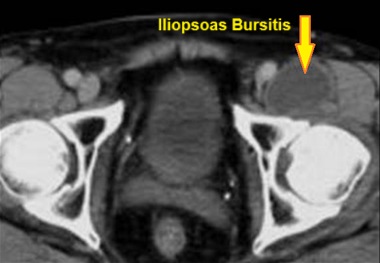
- X-rays: While X-rays may not show the inflamed bursa, they can help rule out bony abnormalities, e.g. arthritis or hip impingement.
- Ultrasound: Ultrasound can visualize the inflamed bursa and assess the surrounding soft tissues, making it a valuable tool for diagnosing bursitis.
- MRI: An MRI provides a detailed view of both the bursa and the surrounding muscles, tendons, and bones. It’s useful for identifying bursitis and any associated hip conditions e.g. labrum tears
Diagnostic Injections
To confirm the source of pain, your doctor may inject a local anesthetic and corticosteroid into the iliopsoas bursa. If the injection relieves the pain, it’s a clear indication that the bursa is the source of the problem.
Differential Diagnosis
Several conditions can mimic the symptoms of iliopsoas bursitis. Some of these include:
- Hip Osteoarthritis: Degeneration of the hip joint cartilage can cause groin pain similar to bursitis, but it is typically accompanied by joint stiffness and grinding sensations.
- Hip Labral Tear: A tear in the cartilage around the hip joint can cause sharp pain in the front of the hip, often worse with certain movements, similar to bursitis.
- Hip Flexor Injury: A hip flexor strain or hip flexor tendonitis can cause pain that is often indistinguishable from iliopsoas bursitis, as both conditions affect the same region.
- Groin Strain: Overstretching of one of the hip adductor muscles can cause inner thigh pain
- Hip Impingement: Structural abnormalities in the hip joint can cause pinching of the labrum and joint tissues during movement, leading to similar groin pain.
- Inguinal Hernia: A hernia in the groin can present with localized pain and swelling, but it may be more prominent with abdominal straining or lifting.
- Snapping Hip Syndrome: audible or palpable snapping or popping with hip movements
- Sciatica or Lumbar Radiculopathy: Spinal problems and nerve impingement can cause referred pain to the hip or groin. It is often accompanied by tingling or numbness. Find Out More >
#CommissionsEarned from Amazon on qualifying purchases
Iliopsoas Bursitis Treatment
The goal of iliopsoas bursitis treatment is to reduce inflammation, relieve pain, and restore normal function. Treatment options include:
1. Rest and Activity Modification
Rest is one of the most effective treatments for iliopsoas bursitis. Avoid activities that worsen the pain, such as running, climbing stairs, or prolonged sitting to allow the bursa to heal. Short-term rest from intense activities can alleviate symptoms, though maintaining some movement to prevent stiffness is essential.
2. Ice and Heat Therapy
Applying an ice pack to the front of the hip for 15-20 minutes several times a day helps reduce inflammation and relieve pain. Once the acute inflammation subsides, heat therapy can be used to relax tight muscles around the hip.
3. Medication
NSAIDs like ibuprofen can help reduce pain and inflammation. They are useful for short-term symptom relief, especially during flare-ups, but always check with your doctor before taking medication to check it is suitable for you.
4. Physical Therapy

Physical therapy plays a critical role in the long-term management of hip bursitis.
A physical therapist will develop an individualized program of iliopsoas bursitis exercises to stretch and strengthen the muscles surrounding the hip, such as:
- Stretching Exercises: Gentle stretching of the iliopsoas, hamstrings, and hip flexors can alleviate tension and improve flexibility
- Strengthening Exercises: Hip strengthening exercises for your core, glutes, and surrounding muscles helps support the hip joint and prevents further irritation of the bursa
- Postural Training: Correcting posture during activities like sitting, standing, and walking can reduce strain on the hip muscles and bursa
The physio may also use other treatments such as ultrasound therapy or pulsed short wave diathermy to help reduce inflammation in the bursa and speed up healing.
5. Corticosteroid Injections
For more severe or persistent cases, a corticosteroid injection directly into the iliopsoas bursa can provide significant pain relief by reducing inflammation. The injection is often performed under ultrasound guidance to ensure accuracy. While not an overall cure, the pain relief may last several weeks or even months, allowing you to engage in rehabilitation exercises.
6. Ultrasound-Guided Aspiration
If fluid build-up in the bursa is causing significant pain and swelling, aspiration (draining) of the bursa may be performed. This procedure is guided by ultrasound to ensure precision and may also be combined with a corticosteroid injection.
Surgery
Surgery is rarely necessary for iliopsoas bursitis, but in chronic or severe cases where conservative treatment fails, bursectomy (removal of the bursa) or iliopsoas tendon release may be considered. Both types of surgery are usually minimally invasive, using an arthroscopic approach to reduce recovery time and complications.
FAQs about Iliopsoas Bursitis
1. What Does Iliopsoas Bursitis Feel Like?
1. What Does Iliopsoas Bursitis Feel Like?
Iliopsoas bursitis typically causes deep, aching pain in the front of the hip or groin. The pain may radiate to the inner thigh or lower back and is often worse with activities like walking, running, or climbing stairs. Stiffness and a snapping or clicking sensation in the hip are also common.
2. How Do You Get Rid Of Iliopsoas Bursitis?
2. How Do You Get Rid Of Iliopsoas Bursitis?
Iliopsoas bursitis treatment involves rest, avoiding aggravating activities, applying ice, taking anti-inflammatory medications (NSAIDs), and engaging in physical therapy and iliopsoas bursitis exercises to stretch and strengthen surrounding muscles. Corticosteroid injections may be used for more severe cases, and surgery is rarely needed.
3. How Long Does It Take For The Iliopsoas Bursa To Heal?
3. How Long Does It Take For The Iliopsoas Bursa To Heal?
Healing time varies depending on the severity, but most cases of iliopectineal bursitis improve within a few weeks to a couple of months with proper treatment. Consistent rest, physical therapy, and activity modification are key to faster recovery.
4. What Should I Avoid With Iliopsoas Bursitis?
4. What Should I Avoid With Iliopsoas Bursitis?
Avoid activities that exacerbate hip flexion, such as running, cycling, or excessive sitting. Also, steer clear of high-impact exercises and sudden, intense movements that put extra strain on the hip.
5. What Are The Different Types Of Hip Bursitis?
5. What Are The Different Types Of Hip Bursitis?
There are three different types of hip bursitis. Trochanteric bursitis affects the outer hip bursa near the greater trochanter, causing pain on the outside of the hip, while iliopsoas bursitis affects the bursa at the front of the hip, leading to groin pain.
Ischial bursitis affects the bursa that are directly under the sitting bones and results in buttock pain, particularly when sitting. The location and causes of the pain differentiate these three types of bursitis.
6. Can You Exercise With Iliopsoas Bursitis?
6. Can You Exercise With Iliopsoas Bursitis?
Yes, but low-impact activities are recommended. Iliopsoas bursitis exercises that focus on gentle stretching and strengthening of the hip flexors, core, glutes and surrounding muscles can help, but high-impact exercises should be avoided until symptoms subside.
7. How Do You Test For Iliopsoas Bursitis?
7. How Do You Test For Iliopsoas Bursitis?
A healthcare provider may use a combination of a physical exam, where they test hip range of motion and palpate for tenderness, and imaging tests like ultrasound or MRI to confirm the diagnosis of iliopsoas bursitis. Sometimes, diagnostic injections are used to localize the pain source.
8. How Can You Prevent Iliopsoas Bursitis?
8. How Can You Prevent Iliopsoas Bursitis?
Preventing iliopsoas bursitis involves maintaining strong, flexible hip and core muscles, warming up properly before activities, and avoiding repetitive strain on the hip. Gradually increasing activity levels and ensuring proper posture during sitting and exercise can also help prevent bursitis.
Summary
Iliopsoas bursitis is a painful condition that can significantly impact daily activities and athletic performance, especially due to its effect on hip mobility. It often results from overuse, injury, or repetitive stress on the hip flexor muscles, leading to deep, aching pain in the groin or front of the hip. Early diagnosis and treatment are key to avoiding long-term complications and ensuring a smooth recovery.
With the right diagnosis and a tailored treatment plan—including rest, physical therapy, and sometimes medication—most people can recover fully and return to their regular activities within a few weeks to a few months.
There are two other types of hip bursitis that can develop:
- Trochanteric Bursitis: over the outer hip
- Ischial Bursitis: under the sitting bones
You may also be interested in the following articles:
- Front Hip Pain
- Upper Thigh Pain
- Hip Impingement
- Hip Labral Tear
- Hip Muscle Anatomy
- Groin Strain
- Hip Flexor Strain
- Pain Above The Knee
Related Articles
Knee Pain Diagnosis
March 27, 2025
Hip Pain Diagnosis
September 16, 2025
Hip Strengthening
September 24, 2025
Last Updated: September 8th, 2025
Next Review Due: September 8th, 2027
